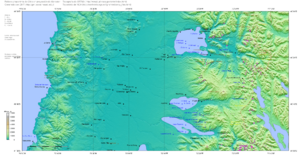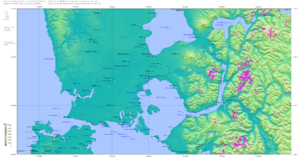Cunco people facts for kids
The Cuncos (sometimes called Juncos) were a group of Huilliche people who lived along the coast and nearby inland areas of southern Chile. They are mostly known from historical records, especially because of their long conflicts with the Spanish Empire during the time Chile was a Spanish colony.
The Cuncos were farmers. They grew important crops like maize (corn), potatoes, and quinoa. They also raised animals called chilihueques, which were similar to llamas. To get more food, they would travel to the coast in spring and summer. There, they would gather shellfish and hunt sea lions. They were said to live in large traditional houses called rukas.
Cuncos lived in small local groups led by chiefs. These groups were connected through families and clans, and people were very loyal to their local area.
Contents
Who Were the Cuncos?
It's not completely clear who the Cuncos were as a distinct group. Some historians say "Cunco" was a name the Spanish used for certain Mapuche-Huilliche people in southern Chile during colonial times. The Spanish called them indios cuncos. However, some experts believe the Spanish might have used the term "Cunco" just to describe people living in a certain area, rather than a specific ethnic group.
Historians also note that the differences between the southern Mapuche groups are not well understood. But their customs and language seemed to be similar. Some believe the Cuncos were quite different from the Mapuche of the Araucanía region. They were also seen as different from other nearby Huilliches. The Cuncos who lived in the main part of their territory were known for strongly resisting Spanish rule. The Spanish even thought the Cuncos were the wildest of the southern Mapuche groups.
Where Did the Cuncos Live?
Old records from Jesuit priests say the Cuncos lived in the area between Valdivia and Chiloé Archipelago. They lived on the mainland north of Chiloé, reaching as far north as the "Araucanian barbarians" (Mapuche from Araucanía).
The Cuncos lived in the Chilean Coast Range and its hills. The proper Huilliches lived to their east, in the flatlands of the Central Valley. There are different ideas about how far south the Cunco lands reached. Some say the Maullín River was their southern border. Others believe they lived all the way to the middle of Chiloé Island. One theory suggests the Cuncos settled in Chiloé Island before the Spanish arrived. This might have happened because other Huilliches pushed them south. The native people of northern Chiloé Island, who had Mapuche culture, are sometimes called Cunco, Huilliche, or Veliche.
Spanish records described the Cunco lands as rainy. They had many swamps, rivers, and streams. The forests were thick with tall, strong trees. There was not much flat, open land. The local roads were very narrow and in poor condition.
It's important not to confuse the Cuncos with people from the town of Cunco, which is located further north.
What Language Did They Speak?
Historians mention that the Cunco language was like an accent or dialect. It was similar to "Chiloense," the language spoken by the native people of the Chiloé Archipelago. It's believed that the languages of the Huilliches, Cuncos, Pehuenches, and Araucanians (Mapuche) were all similar enough for them to understand each other.
Conflicts with the Spanish
After the Spanish city of Osorno was destroyed, the Cuncos had bad relations with the Spanish settlements of Calbuco and Carelmapu. These towns were built by Spanish people who had fled Osorno, along with loyalist Indians. In fact, the area between Reloncaví Sound and the Maipué River became empty because of this conflict. It involved not only fighting but also capturing people for forced labor.
On March 21, 1651, a Spanish ship called San José was heading to the newly rebuilt city of Valdivia. Storms pushed the ship onto the coast where the Cuncos lived, south of Valdivia. The ship got stuck, and most of the crew survived the wreck. But nearby Cuncos killed them and took the valuable cargo. The Spanish tried to get back what was left, but they failed.
Two groups of Spanish soldiers were sent to punish the Cuncos. One group started from Valdivia and went south. The other started from Carelmapu and went north. The group from Valdivia failed because the Mapuche people, who were supposed to help the Spanish, did not support them. While the Spanish were away from Valdivia, hostile local Mapuches killed twelve Spanish soldiers. The Valdivia group soon ran out of supplies and went back without fighting the Cuncos. The group from Carelmapu was more successful. They reached the site of the abandoned city of Osorno. There, Huilliches met them and handed over three chiefs. These chiefs were said to be involved in the looting and killing from the shipwreck.
The Governor of Chile, Antonio de Acuña Cabrera, planned another Spanish attack against the Cuncos. But Jesuit priests convinced him not to. They warned that a large military attack could break the peace agreements made with other native groups.
The Cuncos were also involved in a failed attempt by the Juan de Salazar to capture people in 1654. This ended in a Spanish defeat at the Battle of Río Bueno. This battle helped start the big Mapuche uprising of 1655.
Even though the Cuncos had some conflicts with the Spanish from Valdivia, like in the 1650s and 1750s, their relationship with the Spanish in Calbuco, Carelmapu, and Chiloé was generally more hostile. The Spanish in Valdivia were slowly able to expand their territory. They did this through trade and buying land in the late 1700s. Eventually, Spanish control reached all the way from Valdivia to the Bueno River.
During a time of renewed conflict in 1770, the Spanish destroyed a road the Cuncos had built. This road went from Punta Galera to Corral and was used by the Cuncos to attack the Spanish. After a big raid by Tomás de Figueroa through Futahuillimapu in 1792, a Cunco leader named Paylapan (Paill’apangi) sent messengers. These messengers went to take part in peace talks with the Spanish at the Parliament of Las Canoas.
Images for kids
See also
 In Spanish: Pueblo cunco para niños
In Spanish: Pueblo cunco para niños



